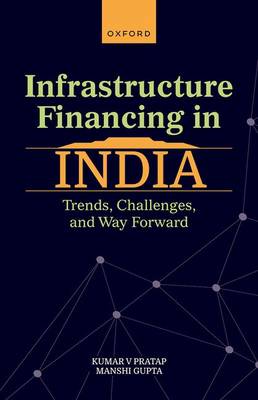
Je cadeautjes zeker op tijd in huis hebben voor de feestdagen? Kom langs in onze winkels en vind het perfecte geschenk!
- Afhalen na 1 uur in een winkel met voorraad
- Gratis thuislevering in België vanaf € 30
- Ruim aanbod met 7 miljoen producten
Je cadeautjes zeker op tijd in huis hebben voor de feestdagen? Kom langs in onze winkels en vind het perfecte geschenk!
- Afhalen na 1 uur in een winkel met voorraad
- Gratis thuislevering in België vanaf € 30
- Ruim aanbod met 7 miljoen producten
Zoeken
Infrastructure Financing in India
Trends, Challenges, and Way Forward
Kumar V Pratap, Manshi Gupta
Hardcover | Engels
€ 217,95
+ 435 punten
Omschrijving
Governments the world over want to spend more on infrastructure (the benchmark for developing countries is 7-8% of GDP per annum) to lay the foundation for sustained and inclusive growth. India is no exception. It realizes that more needs to be spent on infrastructure for the country to regain its position as the fastest growing large economy in the world. While India spent about 7.2% of its GDP on infrastructure during the Eleventh Plan period (2008-12), this number has recently come down to approximately 5%. The backdrop of the book is the ambitious National Infrastructure Plan (NIP); the Task Force report on the NIP was finalized in April 2020. Since infrastructure investment is crucial to faster and inclusive growth, it is timely that the NIP is actioned now, given that the Indian economy contracted to 7.3% in the financial year 2020-21. This book discusses various aspects of infrastructure financing in detail, with a major section devoted to green financing of infrastructure.
Specificaties
Betrokkenen
- Auteur(s):
- Uitgeverij:
Inhoud
- Aantal bladzijden:
- 432
- Taal:
- Engels
Eigenschappen
- Productcode (EAN):
- 9780198884934
- Verschijningsdatum:
- 22/03/2024
- Uitvoering:
- Hardcover
- Formaat:
- Genaaid
- Afmetingen:
- 147 mm x 231 mm
- Gewicht:
- 680 g

Alleen bij Standaard Boekhandel
+ 435 punten op je klantenkaart van Standaard Boekhandel
Beoordelingen
We publiceren alleen reviews die voldoen aan de voorwaarden voor reviews. Bekijk onze voorwaarden voor reviews.









